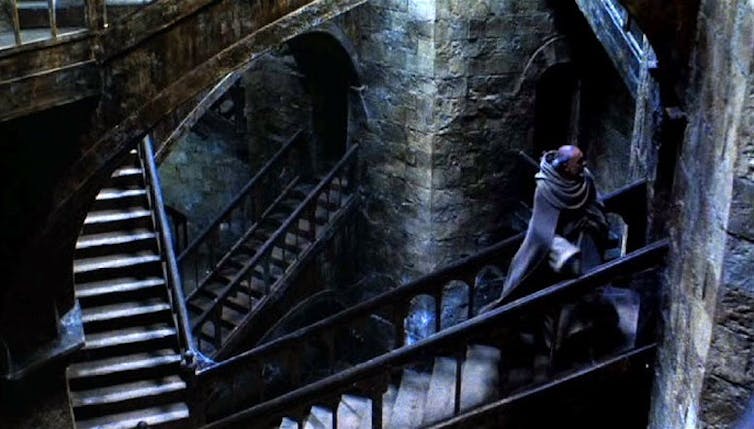
By José Alberto Moráis Morán and María Dolores Teijeira Pablos
The Middle Ages began with the rise of Christianity in Western Europe in the 4th century, and went up to the period of Gothic art from the 13th to the 15th centuries. It is a era that is typically imagined in cinema, television, literature and Romantic paintings as dark and sinister, plagued by the diseases that ravaged Europe, with filthy, unhealthy cities and buildings.
This can be seen in both the novel and film The Name of the Rose, where the buildings are drab and chilly. Similarly in the series Game of Thrones – set in a fictionalised world that draws heavily on the medieval period – war, violence and death dominate society.
Even in drama series The Pillars of the Earth, romanesque buildings were taken as examples of harsh, grim architecture. The Middle Ages have always been characterised by muddy streets, cold palaces, rough stone walls, and an overall atmosphere of depression.

IMDB
However, research by Medieval scholars in recent decades – combined with new digital reconstruction techniques – has shattered these myths, presenting us with a wholly different picture. Thanks to the study of written sources, archaeological sources and, above all, physical objects and buildings, a startlingly colourful panorama is beginning to appear.
Glimpses into the High Middle Ages
Most experts consider medieval art and architecture to have emerged in the 4th century. In many cases, buildings that have survived to the present day are heavily modified, or even ruined.
Experts have reconstructed, for example, Old Saint Peter’s basilica, erected in the Vatican City by Emperor Constantine, which has since been demolished and replaced with the building that stands there today. The data found by historical researchers was used to create a virtual model of the building.
Inside, it was filled with colour. It was airy and bright thanks to large windows, and the fixtures were sumptuous, showing off slender proportions in its columns. The building, with its marble, mosaics, textiles, and other elements, dispels the myth that medieval architecture is dark and sinister. In fact, many buildings of the early Middle Ages were painted in bright colours, though the passage of time has erased these fragile murals.
These reconstructions are not some exaggerated fantasy for a mass audience, but the fruit of years of documentation work by scholars.
The monastery churches, basilicas and cathedrals of these periods were not dreary, nor were their walls frigid, bare stone. Even when buildings have completely disappeared, work such as that on the Romanesque cathedral of Gerona, in Catalonia (Spain) has created a splendid image of its interior, where everything shone: the painted walls, the gold and silver canopies, the rich fabrics, and the candles and tapers that illuminated every nook and cranny.
Gothic cathedrals and light
Large Gothic cathedrals are often depicted as dark, unsettling spaces. This is the way Notre Dame Cathedral, in Paris, is presented in Victor Hugo’s 1831 novel The Hunchback of Notre Dame, as well as in the 1996 Disney film of the same name.
This image could not, however, be any further from the truth. The technical prowess involved in many buildings erected between the 12th and 15th centuries allowed for the presence of large stained glass windows. These cast shimmering beams of light inside, which caressed the buildings’ walls, pillars and furnishings. The light inside Gothic temples generated an atmosphere that enhanced the spiritual experience of the faithful, and aimed to bring them closer to God.

Madrugada Verde / Shutterstock
A lot of the furniture from these buildings has long since disappeared, but the conscientious studies of researchers such as Fernando Gutiérrez Baños have allowed us to visualise what the altarpieces and tabernacles of these spaces were like. This was achieved through digital reconstruction, and by rebuilding lost or destroyed elements.
Textiles and tapestries covered walls, floors and altars, giving an almost luxurious air to these spaces of worship. Many of these, however, were sadly lost to fires, damp or robberies.
Spaces filled with colour
The great Gothic cathedrals of France – including Notre-Dame in Paris and Amiens cathedral – have been extensively researched by Stephen Murray and Andrew Tallon, who have made use of laser and structural analysis techniques. Their studies have played a key role in determining how these churches should be restored, especially in the case of Notre Dame, which was badly damaged by fire in April 2019.
Today we know that medieval art was colourful and lively. This much is clear from the colour restoration of the Amiens cathedral façade, with striking reds and blues applied to the sculptures. The application of 3D rendering techniques to the architecture and art of the Middle Ages is a very useful tool in gaining a better understanding of the past.
However, if the aim is to create images close to the initial state of the works, this must always be accompanied by careful studies of documentary sources, archaeology and the artistic works themselves. When that goal is achieved, medieval art, full of clarity, colour and light, reveals itself to us.
![]()
José Alberto Moráis Morán is a professor at the Universidad de León, and María Dolores Teijeira Pablos is an art history professor at Universidad de León.





























Leave a Reply